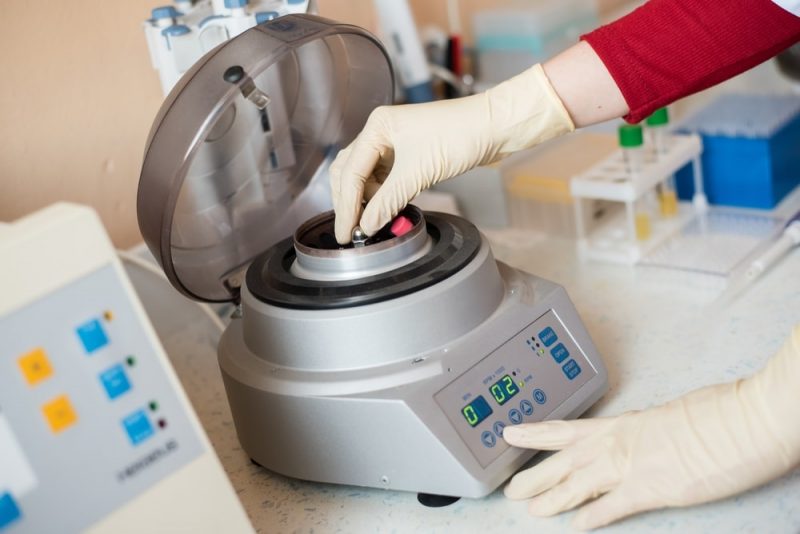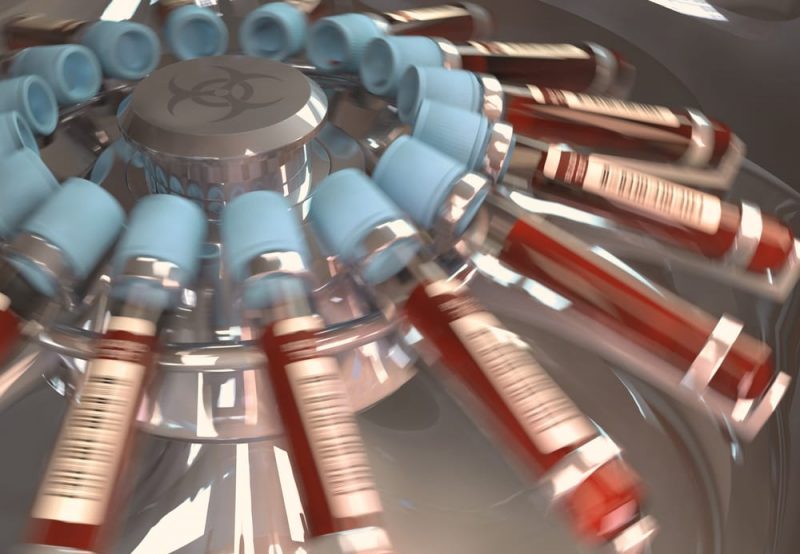The centrifugation It is a method to separate solid substances from liquids of different density in a mixture, as long as the former are insoluble, using rotary force or centrifugal force. For example: washing machine, DNA separation, solids drying.
An instrument called centrifuge or centrifuge, which rotates the mixture on a fixed and determined axis.
As its name suggests (centrifuge: fleeing from the center), this force tends to pull the denser components out of the axis of rotation, leaving the less dense in the very center. It is contrary to centripetal force.
Types of centrifugation

- Differential. Based on the difference in density of substances, it is the basic but inexact technique.
- Isopychnic. This technique is used, for example, to separate particles of similar size but with different densities.
- Zonal. The difference in the sedimentation rate of the substances (due to their different masses) is used to separate them in a given centrifugation time.
- Ultracentrifugation. Its power allows the separation of molecules and subcellular substances.
Examples of centrifugation

- The washing machine. This appliance uses centrifugal force to separate clothes (solid) from water (liquid) based on their densities. That is why clothes are usually almost dry when they are removed from the inside.
- Dairy industry. The milk is centrifuged to split its water and lipid content, since the latter are used to make butter, or skimmed milk from the remainder.
- Cars in a curve. When driving fast through a curve in the road, we often feel a force pulling us out of the road, away from the axis of the curvature. That is the centrifugal force.
- Obtaining enzymes. In the medical and drug industry, centrifugation is often used to obtain certain enzymes from the specialized cells that produce them.
- DNA separation. Isopycnic centrifugation is often used in genetic laboratories to separate cellular DNA and allow its further study and manipulation.
- Food for coeliacs. When it comes to separating the protein from gluten from the foods that contain it, the centrifugation process is essential. It is carried out on starch paste, whose gluten content reaches 8%, and is reduced to below 2% in successive selective centrifugations.
- Blood tests. A centrifuge is used to separate elements of the blood, such as plasma and other elements that are commonly mixed in it.
- Acceleration of sedimentation. In various food industries, such as brewing or cereals, centrifugation speeds up the sedimentation processes that gravity generates spontaneously, reducing the waiting time of the raw material.
- Cleaning the latex. In the latex industry, it is necessary to clean the substance, whose surface is particularly prone to the adherence of other particles, and this is carried out through centrifugation, given the low density of the substance.
- Solid drying. Another industrial application of the centrifuge is the drying of crystals or other materials whose production is accompanied by water. As it rotates, the water separates from the solids and is discarded, leaving the desired solids without the liquid.
- Sewage treatment. The centrifugation of the polluted water allows the extraction of dense substances inside, not only solids, but even oils, fats and other unwanted components that, once centrifuged, could be discarded.
- Amusement parks. Many amusement park rides use centrifugal force to generate a vacuum effect on their riders, who are spun rapidly on a fixed axis, tightly attached to a seat that prevents them from being thrown out of the spin axis.
- Stunts motorcyclists. The motorcyclist in a sphere is a classic of the circus, who is able to drive through the roof of the sphere defying gravity. It is capable of doing this after having made many turns on the same horizontal axis, accumulating speed and submitting to the centrifugal force that adheres it to the interior of the sphere. Eventually this force will be so great that it will be able to verticalize the movement and defy gravity.
- Inclination of the train tracks. To counteract the centrifugal force, train tracks are often tilted inward through curves, exerting resistance so that it does not succumb to the force that pushes it outward and does not derail.
- The terrestrial translation. The reason that the gravitational force of the Sun does not push us headfirst into its interior is also due to the centrifugal force that, when rotating on the axis of the sun king, pushes it outward, counteracting and balancing the gravitational attraction.
Other techniques for separating mixtures
- Crystallization
- Distillation
- Chromatography
- Decantation
- Magnetization
